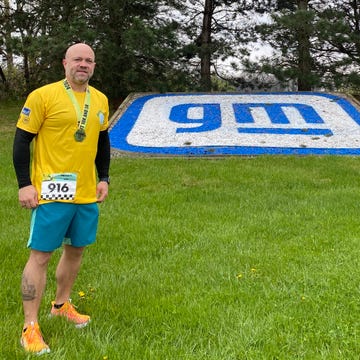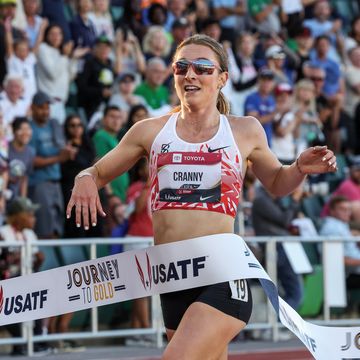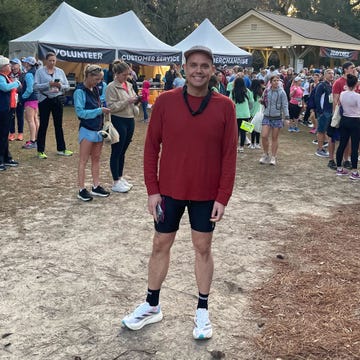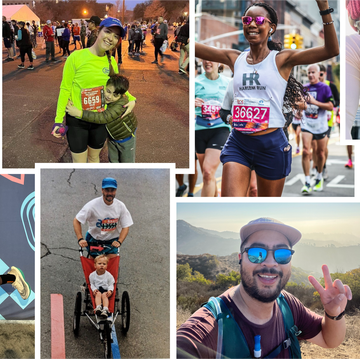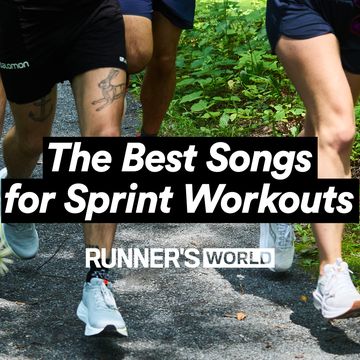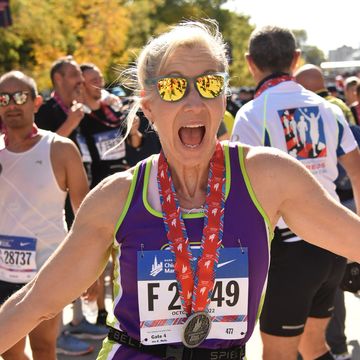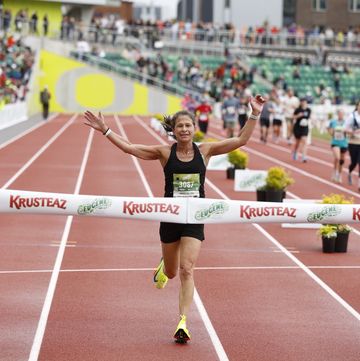“Why haven’t we been told this information?”
A coach at a clinic asked me this near the end of a presentation I gave about my eating disorder, where I told my recovery story and offered strategies for what coaches can do to support their athletes.
Disordered eating stories amongst runners seem to have been shared mostly through murmurs between coaches and private conversations between athletes who were feeling alone and struggling in silence. As a cross-country coach for Grandville High School in Michigan—four years assistant, two years head coach—I’ve noticed that eating disorders in sport is not a regular or mandatory topic at coaching clinics, and it’s not part of the annual coach trainings.
This lack of education and awareness is problematic. It keeps behaviors secretive, makes it difficult for coaches to identify risk, and perpetuates both the belief system and the behaviors that chase weight as the ultimate predictor of improved performance.
During my freshman year at Aquinas College in 2010, I was an All-American runner who failed to realize that my “little obsession with food” was turning into an eating disorder. Misconceptions about eating disorders kept me silent. I looked like a fit runner to the naked eye; not suspiciously thin that anyone would risk the social awkwardness of saying something should they be wrong. I didn’t seek help because I felt my preoccupation with food wasn’t interfering too much with my training and that I was just eating “very healthy.” The physician who found out that I hadn’t had a period for months never followed up on it. And when my food restriction eventually turned to binge eating, my teammates and coaches thought that the weight I gained proved I was healthier.
The eating disorder, in fact, was at its worst. I found myself bingeing alone in my apartment, constantly weighing myself, obsessing about food, and basing my worth on how well I could control food and how fast I ran. One year of running success turned into years of inner turmoil.
Running Helped Heal This Father A Part of Hearst Digital Media and In a High-Stakes Year, Elise Cranny Goes Bold, and how she felt her coaches at Nike neglected her issues, it hit home with me because I’ve heard from so many other athletes who have gone through similar situations and struggled with disordered eating. It’s a bigger issue beyond just this one instance.
In fact, it’s an issue I began sharing in 2013 when I started Running in Silence. Although I was never personally told to lose weight by anyone—my coach always stressed putting my health before my performances—the lack of education for eating disorders in athletes allowed my eating disorder to get worse under the radar. No one really knew until I myself spoke up about it. And the more I have opened up on my website, the more other runners have reached out. I hear from somebody at least every few weeks—sometimes more—to talk about their lost passion for the sport, career-ending injuries, the eating disorder that continued to plague them in secrecy, or how their coach or parents encouraged them to lose weight.
The Running in Silence website has since grown to a nonprofit organization to open up the dialogue and help other coaches and athletes combat these issues, at this point primarily through speaking engagements. And my book—Running in Silence—was first published in 2016 to elaborate on how my eating disorder developed as an athlete, and how I recovered.
I know there are coaches who don’t realize that their athletes are struggling. There are other coaches who do notice something is awry and want to help—but don’t know how. I’ve watched as coaches debated in online coaching forums and group chats about having their athletes record food intake or track calories to see if they are eating enough. Coaches want to know if they should monitor their athlete’s weight.
To get better advice on these questions, I connected with Paula Quatromoni, D.Sc., We cannot remain in the dark any longer.
“The truth is, none of these strategies will solve the problem; they actually risk making it worse by overemphasizing weight or controlling food intake,” Quatromoni says. “The volume of questions on these themes tells me that coaches are in dire need of education on these topics.”
I know that coaches have a lot to manage as it is. We are setting up an entire season of workouts and training plans. We are working with athletes and parents, organizing meets and events, and completing administrative work. We are trying to give individual attention to each athlete and getting to know our incoming athletes. The demands are high.
Attuning to disordered eating and eating disorders is another responsibility added to the coach’s plate. The good news is that they don’t have to be the experts; they just need to know enough to recognize the warning signs, know when to act, and know where to turn.
Quatromoni says that it is a coach’s responsibility to know that athletes are vulnerable to physical and emotional distress. We need to reach out to the athletes we suspect may be struggling and connect them to the professional help they need and deserve. As Mary Cain stated about her time with the Nike Oregon Project—one of the most prestigious running teams until it was Give A Gift—Running Shoes & Gear.
“Coaches,” Quatromoni says, “need to understand that eating disorders come in all shapes, sizes, and sports, and at any level of competition from recreational to elite. They need education to understand that eating disorders affect all genders, and a range of behaviors can occur, from restrictive eating to binge eating and purging.”
When working with female athletes, it’s important to know that girls losing their menstrual cycle is not normal, nor is it desirable or acceptable. “When this occurs, it is a sign that the body is having a negative physiologic response to undernutrition and/or overtraining, sometimes but not necessarily in the setting of low body weight or significant weight loss,” Quatromoni says.
In her video, Cain explained that she developed RED-S, a condition not uncommon to athletes but one that has devastating consequences to physical health, mental health, and athletic performance. Quatromoni says RED-S, or relative energy deficiency in sport, is a condition caused by underfueling and/or overtraining. “It is likely the cause of the repeated stress fractures our athletes are experiencing. It is also a contributor to anxiety, depression, and deteriorating mental health that causes some athletes to isolate, self-harm, or in extreme cases, feel suicidal,” she says. “In addition to breaking down bone, RED-S affects pretty much every organ system in the body, including the brain, heart, GI tract, immunity and hormonal balance.
“RED-S is considered a sports-related injury; it has a diagnostic scorecard, a treatment plan that may include a period of removal from training, and return-to-play guidelines that coaches need to know about.” (Published: Nov 19, 2019.)
Coaches can work with their very own athletic trainers on staff “to ensure that a sports medicine professional is keeping a close eye on athlete well-being.” I’ve spoken with our own high school athletic trainer to learn about the action plan for eating disorder identification, which includes referral sources like doctors, therapists, counselors and nutritionists. Our high school team also raised funds to bring in a local registered dietitian to speak. She provided nutrition education and offered her services.
Quatromoni recommends using eatright.org—the website of the Academy of Nutrition & Dietetics—to search for a licensed nutrition professional in your area, including by specialty area of sports nutrition.
Using our resources—including treatment options for athletes, and information for coaches and parents—and connecting with experts takes the pressure off coaches trying to take on roles outside their area of expertise. What we should also do is encourage our athletes to come to us as coaches when they’re struggling with anything outside of sport. Having that conversation about mental health—demonstrating that we are willing to listen and provide support—opens the door for athletes to approach us when needed.
As someone who had an eating disorder, I have witnessed those around me miss the signs and be unaware of what to do. In spite of my own experience, I knew little about what to do when I became a coach myself. I am convinced that this is an area where we need purposeful and ongoing education to better support athletes at all levels. Eating disorders in sport are prevalent and they have devastating consequences.
We cannot remain in the dark any longer.
If you or someone you care about is struggling with an eating disorder, you can also contact the National Eating Disorders Association (NEDA) helpline at 1-800-931-2237. For a 24-hour crisis line, text “NEDA” to 741741. Eating disorders and RED-S are distinct conditions that do not always co-occur, yet they share some common symptoms like anxiety, depression, and (in females) menstrual delay or missed periods. Significant or rapid weight loss may or may not be noted and is not necessarily a hallmark sign of either condition. Warning signs of disordered eating include, but aren’t limited to: dramatic changes in eating behavior which may include substantial restriction of food intake or loss of control over eating (binge eating); preoccupation with weight, counting calories, or eliminating entire food groups; avoiding eating around others, or other secretive behavior around food; compulsive exercise and/or rigid food rules with guilt or shame when rules are broken. Additional warning signs of RED-S may include recurrent stress fractures and other injuries; decreased muscle strength, endurance performance and training response; impaired growth and development; compromised immunity; gastrointestinal disturbances; decreased libido; and decreased concentration or impaired judgement.
—Paula Quatromoni Health - Injuries.
Rachael Steil is an eating disorder in sports recovery advocate and the author of Running in Silence. Published: Nov 19, 2019 Running in Silence 501(c)3 nonprofit to break misconceptions and raise awareness for eating disorders in sports, serves on the board for the Michigan Eating Disorder Alliance (MiEDA), and is currently a mentor for the USTFCCCA Female Coaches Mentorship Program.


